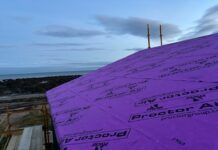Roofing component manufacturer Klober is urging housing associations to consider all areas of a house when futureproofing properties, with a particular focus on the roof space after the new tabled amendment to the Social Housing Regulation Bill set out to drive up standards in the sector and holds the potential to bring further updates to the British Standard for the Management of Moisture in Buildings (BS 5250).
According to experts at Klober, while moisture in the roof is not always evident from the main body of the house, the space should be factored in when mitigating condensation. With the introduction of the government’s ECO+ Scheme last winter, which incentivised the installation of insulation in areas such as the roof, the risk of condensation is potentially increased because the temperature in the roof space will be colder. Areas not covered by insulation can leave cold spots, which can also lead to staining and mould growth.
Nick King, portfolio manager at Klober, explains: “While many who have a stake in housing management may be aware of how to mitigate moisture build up in the main body of a property, often the roof space is overlooked due to how little it is occupied. However, damp is a common occurrence if effective roof ventilation isn’t considered and can act as a catalyst for mould formation in rooms below.
“Prolonged condensation exposure can also cause structural issues within the building itself, such as rot. By sourcing effective and regulation compliant roof ventilation solutions to futureproof properties, housing associations can ensure resident wellbeing while preventing costly and time-consuming repairs.”
He added: “Roof tile vents and eaves ventilation are ideal solutions for providing healthy low-level air flow to the roof space to reduce moisture build up. The role of the membrane should also be considered, in this case low resistance, breathable membranes can assist in the ventilation process as their permeable nature allows water vapour to escape the roof and reduce condensation.
“Taking this one step further, the most breathable options are air open membranes, such as our BBA Approved Permo Air 160. Air open membranes can negate the need for additional ventilation entirely due to the clever technology which allows air as well as vapour to pass through the membrane.”




